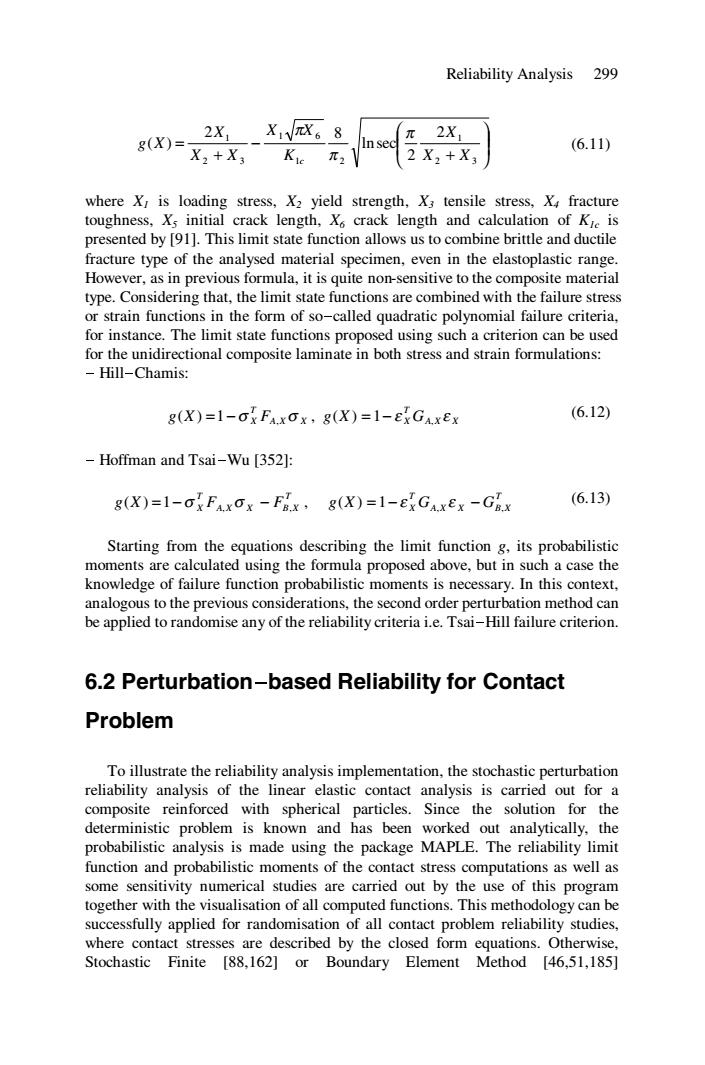正在加载图片...

Reliability Analysis 299 8(X)= 2X XivX 8 π。 2X In sec X2+X, Keπ2 2X2+X, (6.11) where X,is loading stress,X2 yield strength,X3 tensile stress,X,fracture toughness,Xs initial crack length,X crack length and calculation of Kie is presented by [91].This limit state function allows us to combine brittle and ductile fracture type of the analysed material specimen,even in the elastoplastic range. However,as in previous formula,it is quite non-sensitive to the composite material type.Considering that,the limit state functions are combined with the failure stress or strain functions in the form of so-called quadratic polynomial failure criteria, for instance.The limit state functions proposed using such a criterion can be used for the unidirectional composite laminate in both stress and strain formulations: -Hill-Chamis: 8(X)=1-OxFAxOx,8(X)=1-EKGAxEx (6.12) Hoffman and Tsai-Wu [352]: g(X)=1-axFAxOx-Fix,8(X)=1-EKGAxEx-GBx (6.13) Starting from the equations describing the limit function g,its probabilistic moments are calculated using the formula proposed above,but in such a case the knowledge of failure function probabilistic moments is necessary.In this context, analogous to the previous considerations,the second order perturbation method can be applied to randomise any of the reliability criteria i.e.Tsai-Hill failure criterion. 6.2 Perturbation-based Reliability for Contact Problem To illustrate the reliability analysis implementation,the stochastic perturbation reliability analysis of the linear elastic contact analysis is carried out for a composite reinforced with spherical particles.Since the solution for the deterministic problem is known and has been worked out analytically,the probabilistic analysis is made using the package MAPLE.The reliability limit function and probabilistic moments of the contact stress computations as well as some sensitivity numerical studies are carried out by the use of this program together with the visualisation of all computed functions.This methodology can be successfully applied for randomisation of all contact problem reliability studies, where contact stresses are described by the closed form equations.Otherwise, Stochastic Finite [88,162]or Boundary Element Method [46,51,185]Reliability Analysis 299 ⎟ ⎟ ⎠ ⎞ ⎜ ⎜ ⎝ ⎛ + − + = 2 3 1 1 2 1 6 2 3 1 2 2 lnsec 2 8 ( ) X X X K X X X X X g X c π π π (6.11) where X1 is loading stress, X2 yield strength, X3 tensile stress, X4 fracture toughness, X5 initial crack length, X6 crack length and calculation of K1c is presented by [91]. This limit state function allows us to combine brittle and ductile fracture type of the analysed material specimen, even in the elastoplastic range. However, as in previous formula, it is quite non-sensitive to the composite material type. Considering that, the limit state functions are combined with the failure stress or strain functions in the form of so-called quadratic polynomial failure criteria, for instance. The limit state functions proposed using such a criterion can be used for the unidirectional composite laminate in both stress and strain formulations: - Hill-Chamis: A X X T g(X) =1 −σ X F , σ , A X X T g X ε XG ε 1 , ( ) = − (6.12) - Hoffman and Tsai-Wu [352]: T A X X B X T g X 1 X F , F , ( ) = −σ σ − , T A X X B X T g X 1 X G , G , ( ) = − ε ε − (6.13) Starting from the equations describing the limit function g, its probabilistic moments are calculated using the formula proposed above, but in such a case the knowledge of failure function probabilistic moments is necessary. In this context, analogous to the previous considerations, the second order perturbation method can be applied to randomise any of the reliability criteria i.e. Tsai-Hill failure criterion. 6.2 Perturbation-based Reliability for Contact Problem To illustrate the reliability analysis implementation, the stochastic perturbation reliability analysis of the linear elastic contact analysis is carried out for a composite reinforced with spherical particles. Since the solution for the deterministic problem is known and has been worked out analytically, the probabilistic analysis is made using the package MAPLE. The reliability limit function and probabilistic moments of the contact stress computations as well as some sensitivity numerical studies are carried out by the use of this program together with the visualisation of all computed functions. This methodology can be successfully applied for randomisation of all contact problem reliability studies, where contact stresses are described by the closed form equations. Otherwise, Stochastic Finite [88,162] or Boundary Element Method [46,51,185]